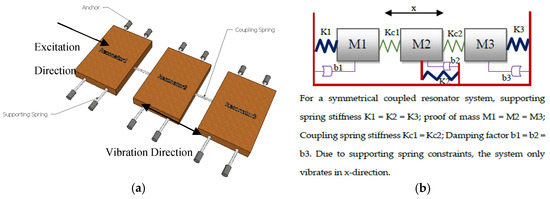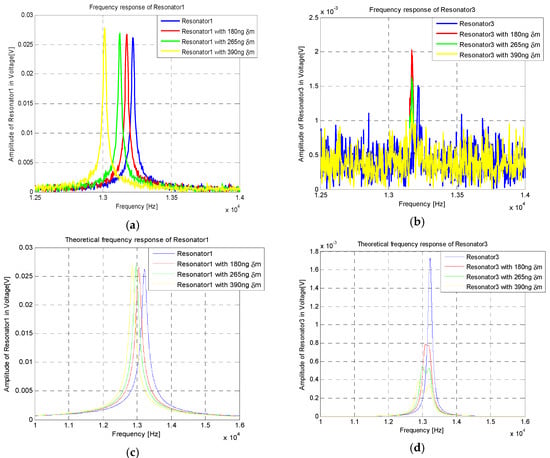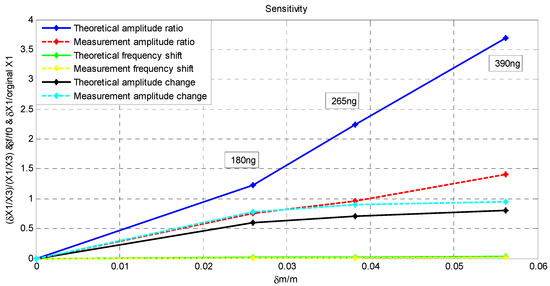Abstract
In this paper, for the first time, the mass sensitivity of a 3-DoF mode localized electrostatic coupled resonator was characterized under atmospheric pressure. A reversible method was used in which nanoparticles are added on and removed from one resonator of the 3-DOF coupled resonator system. Besides, a comparison of three mass sensitivity characterization methods was carried out: resonance frequency shift, amplitude change and resonance vibration amplitude ratio. The results show that a 3-DOF mode localized coupled resonator has potential to be employed for biosensing applications.
1. Introduction
Micro-electro-mechanical-system resonators are rapidly developing and are used for many sensing applications. Various micro-resonators have been designed which typically are one degree of freedom (1-DOF) devices. Common 1-DOF resonators include cantilevers, acoustic resonators and membranes [1]. Using suitable signal pick-off techniques (electronically or optically), 1-DOF resonators have the capability to achieve extremely high sensitivity compared to conventional macro-sensors. However, the normalized sensitivity of 1-DOF resonators is physically constrained. The emergence of coupled resonators with multi-degree of freedom has pushed the sensitivity boundary further. Multi-DOF coupled resonators for mass sensing applications are able to reach biological cell levels [2], employing their enhanced sensitivity [3].
Recently, a sensing methodology has been put forward based on mode localization. It uses the ratio of the resonant amplitudes of the resonators as an output metric. Such an approach can concurrently achieve high sensitivity and good common mode rejection [4,5]. Zhao et al. [6] demonstrated a 3-DOF weakly coupled resonator sensor utilizing mode localization to achieve approximately three orders of magnitude enhancement in stiffness change sensitivity compared to a similar sized conventional 1-DOF MEMS resonator when operated in vacuum. Furthermore, Montaseri [7] performed similar experiments under atmospheric pressure. It was demonstrated with the same stiffness perturbation that the change of the resonator amplitude ratio was significantly higher than that of the resonant frequency shift, indicating the resonator amplitude ratio is an output metric with higher sensitivity with respect to perturbations.
In this work, a 3-DOF coupled resonator chip is studied as a mass sensor by replacing the stiffness perturbations with perturbations by adding or removing mass.
2. 3-DOF Coupled Resonator Chip and Methodology
The 3-DOF coupled resonator chip was fabricated by using an SOI process. The chip design and fabrication is described in detail in [4]. A simplified system model is shown in Figure 1a. In Figure 1b, a spring-mass-damper system model is depicted to illustrate the mechanism of 3-DOF coupled resonator. A solution containing 10 μm diameter magnetic nanoparticles with a concentration of 5 mg/mL was used to be added on resonator1. First, the concentration of magnetic nanoparticles was diluted to 2 mg/mL with an Eppendorf tube. Next, a SonoPlot GIX Microplotter was used to dispense a small droplet (~20 nL) of diluted magnetic nanoparticles solution on resonator1. In Figure 2a, the method to calculate the dispensed weight of nanoparticles is illustrated. Figure 2b exhibits the Microplotter system. After the carrier solution (70% ethanol) evaporated, the solid magnetic nanoparticles were firmly attached to the resonator surface and accordingly a change of effective resonator mass was achieved. Figure 3 shows the dispensing process and magnetic nanoparticles on resonator1, respectively. Then, the 3-DOF coupled resonator, with a mass perturbation on resonator1, were tested with an interface circuit measuring the motional current of resonators1 and 3. The corresponding system frequency response was captured by a Lock-in amplifier (Anfatec eLockIn204/2).The resonance frequency shift, amplitude change and resonance amplitude ratio were acquired and calibrated with the data obtained from the unperturbed system.

Figure 1.
(a) 3-DOF coupled resonator system model; (b) Lumped parameter spring-mass-damper schematic diagram of the 3-DOF coupled resonator system.

Figure 2.
(a) Computation of dispensed weight of magnetic nanoparticles, where h is the change of liquid level; (b) SonoPlot GIX Microplotter system.

Figure 3.
(a) Microplotter tip above resonator1 of 3-DOF coupled resonator chip; (b) magnetic nanoparticles attached to resonator1; (c) magnetic nanoparticles been washed away.
Magnetic nanoparticles were consecutively added three times for sensitivity characterization. After the experimental procedure, the attached magnetic nanoparticles on resonator1 could be removed using solution and a permanent magnet. This allows reversibility of the experiment.
3. Results
The frequency responses of the 3-DOF coupled resonator system for three mass perturbations (180 ng, 265 ng and 390 ng) are shown in Figure 4a,b. Moreover, the theoretical frequency responses of both reasontor1 and resonator3 are obtained by MATLAB simulation and are illustrated in Figure 4c,d.

Figure 4.
The frequency response of 3-DOF coupled resonator system after threeconsecutive mass perturbations. (a) Frequency response of Resonator1; (b) frequency response of Resonator3; (c) simulated frequency response of Resonator1; (d) simulated frequency response of Resonator3.
4. Discussion
The corresponding resonance frequency shift, amplitude change and the change of resonance amplitude ratio versus normalized mass perturbation are presented in Figure 5, where m is the mass value of resonator1 and δm is the mass perturbation on resonator1. The amplitude change is the deviation in resonator amplitude compared to the unperturbed amplitude at the unperturbed resonance frequency, whereas amplitude ratio is the ratio of vibrational amplitudes of resonators1 and 3 at resonance. Also, a comparison with a theoretical model is included. The calculated normalized mass sensitivity of each output metrics summarized in Table 1. It can be seen that the change of the resonance amplitude ratio yields a sensitivity around two times larger than amplitude change and around two orders of magnitude larger than frequency shift.

Figure 5.
Theoretical (simulated) and experimental sensitivities of 3-DOF coupled resonator system.

Table 1.
Normalized mass sensitivity.
5. Conclusions
With a novel reversible method to add nanoparticles as mass changes, this work has characterized the mass sensitivity of a 3-DoF mode localized electrostatic coupled resonator under atmospheric pressure. Future effort of this work constitutes an important step towards realizing a biosensor for concentration measurement using a mode localized sensor operating in air.
Conflicts of Interest
The authors declare no conflict of interest.
References
- Zhao, C.; Montaseri, M.H.; Wood, G.S.; Pu, S.H.; Seshia, A.A.; Kraft, M. A review on coupled MEMS resonators for sensing applications utilizing mode localization. Sens. Actuators A Phys. 2016, 249, 93–111. [Google Scholar] [CrossRef]
- Lin, A.T.-H.; Yan, J.; Seshia, A.A. Electrically addressed dual resonator sensing platform for biochemical detection. J. Microelectromech. Syst. 2012, 21, 34–43. [Google Scholar] [CrossRef]
- DeMartini, B.E.; Rhoads, J.F.; Shaw, S.W.; Turner, K.L. A single input-single output mass sensor based on a coupled array of microresonators. Sens. Actuators A Phys. 2007, 137, 147–156. [Google Scholar] [CrossRef]
- Zhao, C.; Wood, G.S.; Xie, J.; Chang, H.; Pu, S.H.; Chong, H.M.H.; Kraft, M. A sensor for stiffness change sensing based on three weakly coupled resonators with enhanced sensitivity. In Proceedings of the 2015 28th IEEE International Conference on Micro Electro Mechanical Systems, Estoril, Portugal, 18–22 January 2015; pp. 881–884. [Google Scholar]
- Thiruvenkatanathan, P.; Yan, J.; Seshia, A.A. Common mode rejection in electrically coupled MEMS resonators utilizing mode localization for sensor applications. In Proceedings of the IEEE International Conference on Frequency Control Symposium (2009), Besancon, France, 20–24 April 2009; pp. 358–363. [Google Scholar]
- Zhao, C.; Wood, G.S.; Xie, J.; Chang, H.; Pu, S.H.; Kraft, M. A three degree-of-freedom weakly coupled resonator sensor with enhanced stiffness sensitivity. J. Microelectromech. Syst. 2016, 25, 38–51. [Google Scholar] [CrossRef]
- Montaseri, M.H.; Xie, J.; Chang, H.; Zhao, C.; Wood, G.; Kraft, M. Atmospheric pressure mode localization coupled resonators force sensor. In Proceedings of the 18th International Conference on Solid-State Sensors, Actuators and Microsystems, Transducers (2015), Anchorage, AK, USA, 21–25 June 2015; pp. 1183–1186. [Google Scholar]
© 2017 by the authors. Licensee MDPI, Basel, Switzerland. This article is an open access article distributed under the terms and conditions of the Creative Commons Attribution (CC BY) license (https://creativecommons.org/licenses/by/4.0/).